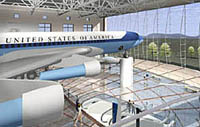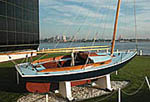Winter 2003, Vol. 35, No. 4
Found at the Presidential Libraries:
Dr. Seuss, Air Force One, and the San Diego Chicken
By Ellen Fried

This rendition shows how Air Force One will look when it goes on display
in the Reagan Library's new museum wing, scheduled to open in late 2004. (Ronald
Reagan Library)
Ten presidential libraries, administered by the National Archives and Records Administration (NARA), serve as rich repositories for the records of our nation's highest office. Together, these libraries house more than 400 million pages of letters, diaries, speeches, memos, and other documents, as well as photographs, film, and audiotape.
But the libraries also keep artifacts of all sizes and descriptions. These items provide tangible evidence of the lives, times, and achievements of the country's chief executives. Some of the artifacts are impressive, some are unique, and some come with poignant or amusing stories. And some of them might surprise you.
Planes, Cars, and Boats
For sheer size and grandeur, it's hard to beat Air Force One. A retired specimen of the President's airborne headquarters arrived at the Reagan Library this past summer.
The Boeing 707 was retired in September 2001, after twenty-eight years of service. It had carried seven U.S. Presidents - every one since Richard Nixon. President Ronald Reagan used this plane exclusively during his eight years in office and logged more miles on it than any of the other six Presidents.
After the plane was retired, it was flown to San Bernardino International Airport, where it was disassembled and stored. Then it made the trip to the Reagan Library in pieces, with one truck towing the enormous fuselage and two others carrying the wings. Visitors will be able to walk through the reassembled Air Force One when it goes on display in a new museum wing, which is scheduled to open in late 2004.
The Reagan Library is the only one with a genuine Air Force One, but plenty of other vehicles can be found at other presidential libraries.
Early in his life, Harry S. Truman recognized the power of mobility. As a young man courting Bess Wallace, he had to take a train to get from his grandmother's farm in Grandview, Missouri, to Independence, where Bess lived. In 1913 he bought his first car - a model Stafford touring car that made the journey much more comfortable and convenient.
His first car may have been a Stafford, but the next was a Chrysler - and from then on, he was loyal to Chryslers.
In November 1940, while Truman was a senator from Missouri, he and his wife purchased two 1941 Chryslers - a coupe and a sedan. After the Trumans moved to the White House in 1945, the cars passed through a series of other owners. By the time they reached the Truman Library, they were in pretty rough shape.
In the mid-1990s, a team from the Chrysler Corporation began meticulously restoring the cars, using records in their own archives to ensure historical accuracy. The Truman Chryslers are now back on display at the Truman Library, looking much as they did when Harry and Bess Truman purchased them more than sixty years ago.
Wheelchair-bound Franklin Delano Roosevelt had his own reason to appreciate the freedom a car could provide. In 1936 he purchased a blue V-8 Ford DeLuxe Phaeton convertible and had it equipped with hand controls for the clutch, brake, and throttle. He used the car at his home in Hyde Park, New York, and with it was able to move freely around his estate and the surrounding countryside.
"He loved that car," said NARA's Richard Claypoole, assistant archivist for presidential libraries. "It was the only thing that gave him mobility."
After President Roosevelt's death, Eleanor Roosevelt donated the car to the Roosevelt Library, where it is now on permanent display.
John F. Kennedy's passion for the sea was legendary, and perhaps no single item better represented that passion than his beloved sailboat, Victura. Dave Powers, a longtime friend of President Kennedy and founding curator of the Kennedy Library, wrote:
Victura was among the President's most prized possessions. A gift on his fifteenth birthday, he sailed it as a young man, Navy hero, Congressman, Senator, and finally as President. It was on the Victura that he began winning races at the age of 15, and on which he taught his wife Jacqueline how to sail. If the President wasn't sailing on Victura, he was thinking about it as evidenced by his many doodles of the sailboat. . . . When the President visited Hyannis Port, he was never happier than when he was at the helm of Victura.

Victura.
(John F. Kennedy Library)
Victura now stands on the lawn of the Kennedy Library, with its bow pointed toward the entrance to Boston Harbor.
Hello, Sports Fans
Many Presidents have been athletes and sports fans - and one President portrayed an athlete in a movie. That's how NARA ended up with some remarkable sports memorabilia in its collection.
Before any other costumed mascot graced a professional playing field, there was the San Diego Chicken. It all started in 1974, when a San Diego State University student named Ted Giannoulas took a weeklong job performing in a rented chicken suit as a promotional stunt for a local radio station. When the gig was up, Giannoulas offered to stay on and attend San Diego Padres games in character. The radio station would get more publicity, and Giannoulas would get to see baseball games for free.
His stadium antics were a huge hit. Before long, the San Diego Chicken had become a celebrity in its home city and was attracting national attention. Other costumed characters started showing up at pro games around the country, but the San Diego Chicken was the first. In 1976 President Gerald R. Ford, himself a former college athlete, met the famous chicken during a visit to San Diego. The encounter sparked an idea in the mind of Jim Naughton, a White House correspondent for the New York Times - and a notorious prankster. Naughton contacted Giannoulas and purchased the head from a San Diego Chicken costume. At a late-night press conference in Portland, as President Ford answered questions from reporters, Naughton suddenly appeared, wearing the big yellow chicken head. The unflustered President didn't miss a beat; he went right on answering questions.
Naughton later donated the chicken head to the Ford Library. The head is not currently on display, but the library plans to exhibit it soon at the Ford Museum, in Grand Rapids, Michigan.
In 1940, young actor Ronald Reagan got his big break - playing the role of Notre Dame football legend George Gipp in the film Knute Rockne - All American. He almost didn't get the part; the producer didn't think he looked like a football player. The producer changed his mind when he saw a photo of Reagan in his college football gear.
In the movie, the dying Gipp tells his coach, "Some day, when things are tough, maybe you can ask the boys to go in there and win just one for the Gipper." The line "win one for the Gipper" would become one of President's Reagan's trademarks.
In 1989, just two days before he left office, President Reagan received a visit from sixty Notre Dame players, their coach, and the university president. They presented the President with a priceless university relic: the monogrammed letter sweater that the real George Gipp wore during his 1917 - 1920 tenure with the Fighting Irish. "That's a great sacrifice by the university," said Reagan. "No one will treasure it more than I will."

George Gipp's Notre Dame sweater.
(Ronald Reagan Library)
The sweater now hangs in the Reagan Library, where other sports fans can admire it as well.
Found at the Presidential Libraries, Part 2
Ellen Fried is on the Policy and Communications Staff at the National Archives and Records Administration.